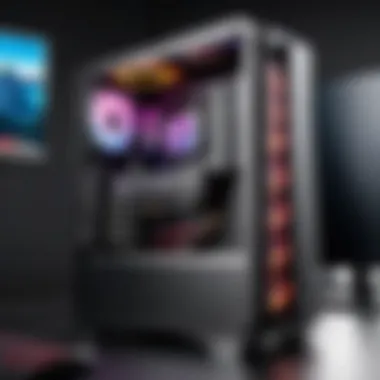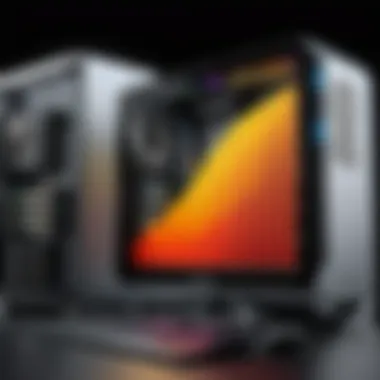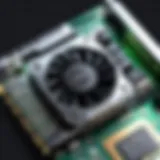Assessing Cost and Value in High-End Prebuilt PCs


Intro
When it comes to investing in high-end prebuilt PCs, the stakes are high. Enthusiasts and professionals often find themselves standing at a crossroads, needing to weigh several factors before forking over their hard-earned money. The allure of superior performance and cutting-edge technology is palpable. However, it’s essential to peel back the layers to determine whether these systems offer genuine value beyond their stylish cases and flashy RGB lights.
In this article, we’ll unpack the market of expensive prebuilt PCs. We will dive deep into aspects such as cost against performance, upgradability options, and how these machines cater to the needs of diverse user groups like gamers, creatives, and professionals. It’s not just about tweaking the specs; it’s about understanding how these systems can fit into your computing life, and whether they deliver what they promise.
Gear up as we embark on this quest to help you decipher the world of high-priced prebuilt PCs, balancing known metrics with intuitive insights that go beyond simple numbers. By the end, you should feel more equipped to navigate this jungle and make a decision that resonates with your expectations and budget.
Understanding Prebuilt PCs
In today's fast-paced tech world, prebuilt PCs are gathering momentum in the eyes of both casual users and seasoned enthusiasts. Buying a prebuilt system appeals to many who find the intricate maze of selecting components daunting. The significance of understanding prebuilt PCs is critical when looking at high-end models, as it can help buyers avoid pitfalls and ensure they are making a sound investment.
When evaluating a prebuilt PC, one must consider both its intended use and the resources it will command. The convenience of a plug-and-play solution often comes with a few strings attached. Here, we’ll dives into what exactly defines these systems and explore the marketplace's nuances that drive their appeal.
Defining Prebuilt Systems
A prebuilt PC is essentially a complete system sold as a ready-to-use package. This can include everything from the central processing unit (CPU) to peripherals like keyboards and mice. Unlike custom builds, which might make a techie’s heart race with excitement, prebuilt systems target those who value efficiency and simplicity.
Typically, these systems come fully assembled, extensively tested, and warrantied. Such an arrangement eliminates the need to grapple with complex compatibility questions of different parts. Whether you need a rig for gaming or graphic design, a prebuilt PC like the Alienware Aurora R13 or HP Omen 30L often fits the bill.
Market Dynamics of Prebuilt PCs
The market for prebuilt PCs operates under a blend of supply and demand principles. There’s a growing trend of gamers and professionals seeking powerful systems without the hassle of assembling their own. Companies are responding by providing high-performance systems at varying price points, capturing market share on all ends of the spectrum.
Several factors influence this market:
- Economic Trends: Economic stability can impact consumer spending on tech gadgets, including prebuilt systems.
- Technological Advancements: As new GPUs and CPUs surface, manufacturers are eager to incorporate them into their systems, influencing the competitive landscape.
- Consumer Preferences: Changes in user demands, whether driven by gaming or professional pursuits, dictate what features and systems manufacturers produce.
The interest in prebuilt PCs often centers on the inherent value of time saved. After all, a busy professional or an eager gamer often lacks the weeks required to research, shop for parts, and build a PC from scratch. Thus, discerning the current marketplace dynamics is essential for anyone thinking about investing in such systems, ensuring one knows exactly where their money is going.
The Cost of Convenience
When it comes to high-end prebuilt PCs, understanding the cost of convenience can't be overlooked. For many users, these systems represent a blend of accessibility and performance. Diving into this topic reveals not just the financial implications but also the practical benefits that make these systems appealing for a variety of users, especially tech enthusiasts and gamers who want to jump straight into action without building from scratch.
Investing in a prebuilt PC often comes down to the sheer convenience it offers. Setting up a custom unit can be akin to assembling a jigsaw puzzle without a picture on the box; it can become frustrating. The cost of a prebuilt PC might seem steep compared to its components when purchased individually, but consider the time, effort, and potential errors involved in a DIY build.
"Time is money, especially in tech, where every second counts."
Listeners of this mantra often gravitate towards prebuilt systems. However, this price tag isn’t just numbers on a screen; it accounts for build quality, support, and warranty. When you buy a prebuilt PC, you're typically paying for:
- Assembly: Each component is carefully chosen and put together by professionals, ensuring compatibility and performance.
- Support: Many suppliers offer extensive customer service, which is invaluable when things go awry. This peace of mind alone can justify the investment for many users.
- Up-to-date Technology: Prebuilt systems often come with the latest hardware innovations, leaving you less likely to lag behind in tech advancements.
Premium Pricing Explained
Premium pricing in the realm of prebuilt PCs can be a double-edged sword. Understanding the factors behind these price tags allows buyers to gauge whether they are getting their money's worth.
One significant influence on premium pricing is brand reputation. Established manufacturers may charge higher prices due to the trust they've built over the years. Users may feel more comfortable investing significant sums of money with brands like Alienware or ASUS. These companies invest heavily in marketing, product development, and customer service, creating a perception of higher value.
Additionally, there’s the aspect of performance. High-end brands often integrate top-tier components that, when assessed by benchmarks, deliver exceptional performance in activities like gaming, content creation, and multitasking.
Here is a closer look at what contributes to premium pricing:
- Quality Components: Leading brands usually use high-grade parts that ensure not only performance but longevity. From thermal paste applications to the power supply units, every component is meticulously curated.
- R&D Costs: Research and development play a key role in pushing the boundaries of what's possible. When you buy a premium prebuilt PC, you're often also paying for the innovation that went into its creation.
- Aesthetic Value: Many users don't just want a machine that works well; they want a machine that looks good. Many premium systems prioritize aesthetic design, which can also significantly affect cost.
Evaluating Price vs. Performance
Navigating the murky waters of price and performance can be quite the task. For many potential buyers, it’s essential to strike the right balance between how much they’re paying versus what they’re actually getting in terms of performance.
The concept of performance metrics is not just about raw power; it extends into usability and user satisfaction. For instance, while a high-priced gaming desktop might boast flagship hardware, the actual user experience can vary based on how well the software and drivers work with it.
When assessing a prebuilt PC, consider the following criteria:


- Benchmark Scores: Look up reviews that showcase how the system handles various demanding tasks. Gaming benchmarks, for instance, can help indicate how well the system performs under load.
- Real-World Use Cases: Performance should align with intended usage. A user aiming to stream while gaming may have different needs compared to someone focused on 3D rendering. Ensure your chosen build aligns with what you plan to do.
- Sustainability: Performance might not just be limited to the immediate output. Consider how future-proof a system is. A slightly higher price could mean a system designed to last through increasing software demands over the years.
In summary, balancing price with performance involves much more than just looking at the numbers. It’s about understanding the value proposition and ensuring that your investment serves you well today and tomorrow.
Components of High-End Prebuilt PCs
When diving into the world of high-end prebuilt PCs, the components inside play a pivotal role. These systems are not just beautiful to look at but are engineered for performance, reliability, and longevity. Understanding these components can demystify the often clouded judgment surrounding these larger investments. Let’s explore the critical elements that make up these powerful machines and why they matter to tech enthusiasts, gamers, and professionals alike.
The Role of the CPU
The CPU, or Central Processing Unit, is often called the brain of the computer. In high-end prebuilt PCs, it’s a key driver behind a system's capability. Modern CPUs from brands like Intel and AMD pack a serious punch, especially in multi-threaded tasks, which is essential for gamers and those working on demanding applications such as video editing or 3D modeling.
The performance of a CPU can be evaluated in various ways, such as:
- Clock Speed: Measured in GHz, higher clock speed means better performance.
- Core Count: More cores allow the CPU to handle more tasks simultaneously.
- Thermal Design Power (TDP): This indicates how much heat the CPU generates, influencing cooling system choices.
When selecting a prebuilt PC, it’s crucial to match your needs with the right CPU—gamers may thrive on higher clock speeds, while content creators might benefit from more cores for demanding software.
"A potent CPU is like a well-oiled machine; it makes everything run smoother, faster, and more efficiently."
Graphics Card Insights
In the realm of gaming and graphic-intensive applications, the graphics card (GPU) is arguably the linchpin. High-end GPUs from leaders like NVIDIA and AMD dictate how rich and immersive your visual experiences can be. Gamers need to pay close attention to the GPU specifications to ensure they can handle the latest games or rendering tasks without breaking a sweat.
Key specifications to scrutinize include:
- VRAM (Video RAM): More VRAM allows for higher resolutions and better textures.
- Support for Ray Tracing: This is a game-changer for achieving realistic lighting in modern games.
- Power Requirements: A robust GPU usually requires a more powerful PSU (Power Supply Unit).
Put simply, a top-notch graphics card can mean the difference between a smooth gaming experience and frustrating lag.
Memory and Storage Configurations
When it comes to memory, most of us think in terms of quantity—how much RAM does the system have? While this is undeniably important, the type and speed of the RAM also count significantly. For high-end prebuilt systems, a minimum of 16GB of DDR4 RAM is preferable, although 32GB or more is often seen in systems tailored for content creation.
Next, we must consider storage. High-end builds typically favor SSDs over traditional HDDs for their speed and reliability. SSDs significantly decrease load times and improve overall responsiveness.
- NVMe M.2 drives offer exceptional speeds compared to SATA SSDs, making them particularly desirable.
A balanced memory and storage setup will ensure that users experience minimal latency and fast data access, crucial for both gaming and professional applications.
Motherboard Considerations
The motherboard is the backbone of any computer, connecting all the components together. It’s essential to select a motherboard that not only supports the CPU but also accommodates upgrades down the road.
Key factors to look at include:
- Chipset Compatibility: Ensure it matches the CPU and supports desired features like overclocking.
- Expansion Slots: Look for sufficient PCIe slots for GPUs or other expansions, plus M.2 slots for additional storage options.
- Build Quality and Features: Durability, cooling options, and onboard connectivity can make a significant difference in performance and user experience.
Ultimately, a high-quality motherboard can enhance the longevity and capability of a prebuilt PC, making it a cornerstone of any major purchase.
By thoroughly understanding these components, buyers can better assess the overall value and performance of a prebuilt system. This also empowers users to tailor their investment to their specific needs and usage scenarios.
Types of Users and Their Needs
Understanding the varied needs of different user types is crucial when considering the purchase of expensive prebuilt PCs. Each category of users – whether they are gamers, content creators, or everyday computer users – has distinct requirements that drive their choices in the gaming or computing market. Not only do these needs influence performance and price considerations, but they also impact the overall value of the investment.
Gamers and Performance Demands
For gamers, performance isn’t just a bonus; it’s the bedrock of their entire experience. The ability to run the latest titles at high settings, maintain smooth frame rates, and provide instant response times can mean the difference between victory and defeat.
Key Aspects:
- Graphics Capability: Today's games are demanding, often needing powerful GPUs like the NVIDIA GeForce RTX series to handle various graphics settings. Gamers usually prefer prebuilt systems with top-notch graphic cards to ensure a stellar gaming experience.
- RAM and Speed: Gamers benefit from having ample memory. A system featuring 16 GB of RAM or more can keep several applications running simultaneously, be it a game, streaming software, or browsers.
- Cooling Solutions: Gaming pushes systems to their limits. Efficient cooling mechanisms, such as advanced fans or liquid cooling systems, are vital in preventing overheating during those marathon gaming sessions.


"Performance is the name of the game, and every millisecond counts."
Content Creators and Workstation Use
Content creators navigate through tasks that require intensive computing power, whether it’s video editing, graphic design, or 3D rendering. They usually require systems that can handle heavy software applications like Adobe Premiere Pro or Autodesk Maya, which demand not only speed but also reliability.
Important Considerations:
- Processor Strength: A high-end CPU, such as the AMD Ryzen or Intel Core i9, can significantly decrease rendering times, providing a smoother workflow for tasks that otherwise take ages on lesser machines.
- Storage Solutions: Fast storage with SSDs is essential, especially for large video files and 3D models. Moreover, systems featuring both SSDs and HDDs can optimize performance and storage efficiency.
- Display Capabilities: Color accuracy and resolution can be critical for creators. Investing in PC setups that include high-resolution monitors or graphics that support multiple displays can be advantageous.
General Users and Everyday Tasks
For general users, those who use their PCs primarily for web browsing, streaming, and office applications, the requirements differ vastly. They might not need the latest GPU or the best RAM, but they still benefit from a well-rounded system that ensures smooth everyday operation.
Key Features to Focus On:
- Reliability and Efficiency: Users generally want a machine that starts up quickly and can handle basic tasks without lagging. A solid mid-range processor can do just that.
- Customer Support and Warranty: Having a reliable warranty can provide peace of mind. Anything that does not work as expected can be a hassle, so choosing brands that offer good customer support becomes a priority.
- Cost-Effectiveness: General users might not want to break the bank. Prebuilt options in the mid-range that balance performance and price will be attractive to these buyers.
Recognizing the distinct needs of gamers, content creators, and everyday users helps paint a clearer picture of the prebuilt PC market. Evaluating specific requirements can guide potential buyers as they search for systems that fit their motifs while also considering cost, performance, and value.
Pros and Cons of Expensive Prebuilt PCs
When diving into the world of prebuilt PCs, especially the pricier models, it’s crucial to weigh both the benefits and the drawbacks. Understanding the pros and cons not only helps users make informed decisions but also uncovers what makes these systems tick. This section will layout the landscape of expensive prebuilt systems, shedding light on the advantages that can draw consumers in and the limitations that might cast some shadows over the prospect of purchasing one.
Advantages of Buying Prebuilt
One of the standout advantages of investing in an expensive prebuilt PC lies in convenience. Most users, especially those not well-versed in the hardware details, appreciate having a system that is ready to go right out of the box. This eliminates the laborious process of selecting individual components, ensuring compatibility, and going through the intricate assembly process.
Here are a few points that highlight the advantages of these systems:
- Time-saving: Instead of spending days—or even weeks—researching individual parts and assembling them, a prebuilt option saves valuable time.
- Optimized Performance: Many high-end prebuilt PCs come with tailored configurations, optimized for specific tasks, such as gaming, video editing, or 3D rendering. This means enthusiasts can potentially get more performance for their money, as manufacturers often balance components effectively.
- Support and Warranty: Purchasing directly from a manufacturer often includes a support system. If anything goes wrong, users have easy access to technical support and warranty services.
- Aesthetic Appeal: Many prebuilt setups come with sleek designs and RGB lighting, appealing to users who prefer a visually striking system.
"A prebuilt PC might just be the perfect answer for those who want a solid gaming or creative setup without diving into the nitty-gritty of hardware selection."
Disadvantages and Limitations
However, as enticing as these advantages sound, it’s equally important to look at the disadvantages of expensive prebuilt PCs. Just because a system appears appealing on the surface doesn’t mean it meets every expectation.
Notably, one significant downside is the price. Often, these systems come with a premium price tag, not only for the components but also for the convenience they offer. This leads to a few critical disadvantages:
- Cost: Premium pricing often means you’re paying more for the convenience of not having to build it yourself. In many cases, you can assemble a similar or even better-performing rig at a lower cost if you don’t mind getting your hands dirty.
- Customization Restrictions: Prebuilt systems may limit users when it comes to customization. Typically, you cannot easily swap out parts, and manufacturers may use proprietary components that aren't upgrade-friendly.
- Potentially Lower Quality in Certain Components: Some manufacturers might cut costs by using lower-tier components in areas such as power supplies or motherboards. This can result in a system that, while it performs well at first, may not hold up over time.
In summary, while there are significant advantages to buying an expensive prebuilt PC, the disadvantages reveal the complexities behind such purchases. Understanding these factors is essential for any prospective buyer looking to make a wise investment in their computing future.
Upgradability and Future-Proofing
Upgradability and future-proofing are critical considerations when it comes to investing in expensive prebuilt PCs. These systems often come with a hefty price tag, and understanding how they can adapt over time is essential for maximizing your investment. Given the rapid pace of technological advancements, the importance of being able to enhance or replace components cannot be overstated.
Assessing Upgrade Potential
When evaluating the upgrade potential of a high-end prebuilt PC, there are several elements to keep in mind. First and foremost, check the motherboard's expandability. A motherboard that supports a variety of slots and ports—like PCIe 4.0 or ample RAM slots—is a strong indicator that the system can accommodate future upgrades. If you plan on enhancing your PC down the line, it’s crucial to ensure that the motherboard will not bottleneck your efforts.
Additionally, consider the power supply unit (PSU). A robust PSU, rated at 80 Plus Gold or better, will provide the necessary headroom to support upgrades, especially for power-hungry components like GPUs. A system that already has a decent PSU can often allow users to sidestep replacing it when upgrading components, which is a significant cost saving.
Another vital aspect is the case design, which should offer ample space and cooling options. A well-ventilated case with enough room for additional fans or upgraded cooling solutions will ensure that your system remains stable as you push it to the limits with newer, more powerful components.
"Investing in a system with upgradeability is like buying a house with room to grow; it accommodates both current needs and future ambitions."
Long-Term Value Considerations
In the context of expensive prebuilt PCs, longevity and sustainability play a pivotal role in determining long-term value. A PC might seem like a great deal today, but if it can’t keep pace with upcoming technologies, the investment could fall flat. Here’s where the concept of future-proofing comes into play.


- Performance Needs Over Time: Your needs may evolve. Gamers might want to switch to a higher resolution or add VR headsets, while content creators may require more power for demanding applications. A system designed for upgradability typically allows for easier integration of higher-end components when your needs change.
- Market Trends: Keeping an eye on industry trends is a wise move. If most games or software increasingly require more robust specifications, having a prebuilt PC that can adapt ensures that you’re not left in the lurch. Scalability is especially important in the gaming world, where the graphics requirements can change overnight.
- Resale Value: An upgradable system holds more value on the second-hand market. If a user knows they can upgrade their GPU or RAM instead of being stuck with dated technology, they’re likely to keep their machine longer, but when they do decide to sell it, the presence of upgrade potential can make it more attractive to buyers.
Investing wisely in upgradability often translates into enhanced performance over time—because the tech landscape is always shifting, and so should your machine be designed to keep up with it.
Brand Comparison in the High-End Market
When diving into the world of expensive prebuilt PCs, it's crucial to pay attention to brand comparison. Each manufacturer carries its own set of strengths and weaknesses, influencing performance, customer support, and warranties. Understanding the landscape of high-end brands helps consumers make informed investments. Opting for a well-regarded brand can often translate to better reliability and performance, something avid gamers and professionals cannot overlook. In practice, this means your choice might be the difference between a smooth gaming experience and regular frustrations during crucial moments.
Leading Manufacturers Overview
Several top-tier brands dominate the prebuilt PC market. Notable ones include Alienware, Razer, Corsair, and HP Omen. Each of these brands has carved out its niche, catering to different aspects of computing needs.
- Alienware: Known for their sleek designs and robust gaming performance, they offer tailored options for gamers. Their systems are often backed by solid customer service, which can be a lifesaver during issues.
- Razer: While initially famous for gaming peripherals, Razer now delivers impressive prebuilt systems that combine aesthetics with power. Their machines are often sought after by gamers who appreciate RGB lighting and high refresh rates.
- Corsair: Their systems are designed with high-quality components that are easily upgradeable. This brand attracts users looking for future-proofing without compromising performance, especially in gaming.
- HP Omen: HP's Omen series emphasizes a balance between gaming and everyday use. They cater to those who might want a powerful gaming rig but also need a versatile machine for work.
Evaluating Brand Reputation
The true value in brand comparison often lies in the reputation upheld by each manufacturer. A decent reputation can provide assurance that the company stands behind its products. This can be assessed through various channels:
- Customer Reviews: Websites like Reddit and tech forums serve as valuable sources of user feedback. Often, real user experiences can shine a light on any potential shortcomings or hidden gems that brands might not advertise.
- Warranty and Support: Investigate the warranty policies. Brands that offer generous warranties show confidence in their products. Support systems in place are equally important; responsive customer service can make resolving issues a less painful process.
- Product Longevity: External reviews or articles often highlight the durability of components used in various systems. Continuous high-performance benchmarks could signal a brand's commitment to quality.
- Peer Recommendations: Sometimes the best way to evaluate is through word-of-mouth. Colleagues or friends who own high-end PCs can offer insights based on personal use, adding to the credibility of a brand's standing.
Upon considering these factors, it becomes clear that selecting a prebuilt PC is more than just a financial commitment. It's an investment in a brand that ideally aligns with your performance expectations and reliability needs.
Making Informed Purchases
In the world of expensive prebuilt PCs, making an informed purchase is not just a smart move; it's a necessity. The stakes are high, both financially and in terms of performance expectations. When someone lays down a hefty sum on a gaming rig or a workstation, they want to ensure they're not just buying a shiny box but an actual powerhouse that meets their specific needs.
Researching Options Effectively
Diving into the ocean of options available today can feel overwhelming. The first step in making a sound decision is thorough research. Start by identifying your primary use cases—are you leaning towards gaming, video editing, or maybe general productivity? Knowing that will narrow down your choices significantly. For gaming, for example, you’ll want a system that has a powerful CPU and GPU. While for heavy content creation, more RAM and faster storage merge as necessities.
Utilize platforms like Reddit or specialized forums, such as the ones found on the TechSpot community. Engaging in discussions can provide invaluable insights beyond what a simple product description covers.
Additionally, there are several comparison sites that allow you to pit different models against each other. Resources like Wikipedia and articles on Britannica provide foundational knowledge that can guide your specs understanding. However, always check the date on articles to avoid outdated information. It's crucial to tap into credible sources and user testimonials, especially when considering high-end models.
Reading Reviews and User Feedback
No research strategy is complete without sifting through consumer reviews. User feedback often paints a picture that's far more revealing than what marketing might illustrate. Don’t just glance at the score; read the comments. Look for patterns concerning performance, reliability, and even customer service experiences.
When searching for reviews, beware of overly positive or negative feedback. Some users might be overly critical or simply had an extraordinary experience. Aim for a balanced perspective. Focus on aspects like:
- Build Quality: Users often share their experiences regarding the durability of their systems.
- Performance in Real Scenarios: What does the machine actually do during long gaming hours or intensive rendering tasks?
- Technical Support: If things go sideways, how responsive is the company?
Pay attention to changes in software compatibility too. Often users will mention if certain systems struggled with specific software versions, which can guide your decision.
A good rule of thumb is to cross-reference multiple sources. Sites like Facebook tech groups also provide up-to-date user opinions that can be more relevant than aging reviews. A combination of insights will give you a fuller picture of the model you're eyeing.
"The best investment is in yourself. The more you learn, the more you earn." - Warren Buffett
Epilogue: The Bottom Line
In the realm of expensive prebuilt PCs, understanding the overall value is paramount. These systems often represent a significant investment, not just in terms of money but also time and expectations. When considering a high-end prebuilt PC, one must weigh the cost against the performance benefits, assessing how well it matches individual needs and use cases.
The importance of evaluating prebuilt systems cannot be overstated. As technology races forward, what seems like a good deal today may be underwhelming in just a few months. This makes informed choices essential, not only to secure the best value for your hard-earned cash but also to avoid the regrettable pitfall of buyer's remorse when the latest components hit the market.
Recapping the Key Points
To distill the essence, let's revisit the main points discussed in this exploration:
- Cost vs. Performance: While prebuilt PCs provide convenience, sometimes they come with a premium price tag that doesn't always reflect superior performance. It's critical to match the purchase with performance requirements.
- User Needs: Different user groups, from gamers to content creators, have unique demands that should guide their purchase decisions. Understanding these needs can help identify the most suitable configuration.
- Upgrade Potential: The flexibility to upgrade components affects long-term satisfaction and can enhance the lifespan of the purchase.
- Brand Value: Reputation and reliability of manufacturers play a crucial role in ensuring that you are investing in a quality product.
Final Thoughts on Value and Investment
Making the decision to invest in a prebuilt PC is, at its core, about aligning expectations with reality. The appeal of high-priced systems often lies in their promise of ready-to-go performance. However, buyers should remain cautious and conduct thorough research before making this leap.
Recognizing the potential trade-offs and benefits will empower buyers to make wiser, more informed choices. In today's fast-evolving tech landscape, what once was a cutting-edge system can quickly become standard fare. Hence, consider each purchase as a step toward an investment that mirrors your ambitions, hobbies, or career needs. Always think ahead—the right choice today could set you up for success tomorrow.
"An investment in knowledge pays the best interest." - Benjamin Franklin
Ultimately, being mindful of both immediate and future requirements while keeping an eye on the dynamic tech landscape will ensure your investment stands the test of time.







